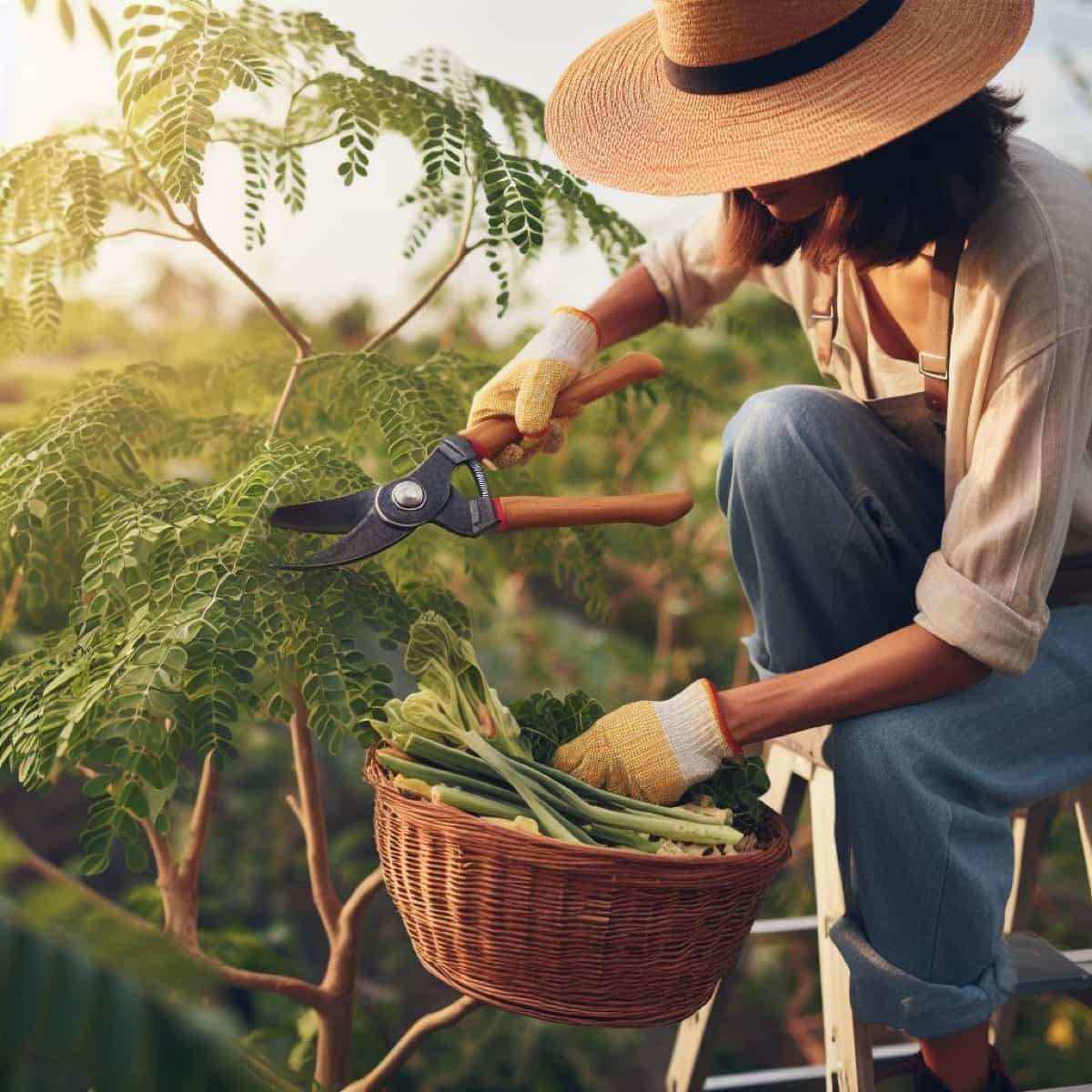Pruning involves selectively removing certain tree parts, such as branches or leaves. This process helps shape the tree, promote air circulation, prevent disease, control height and size, enhance fruit production, and maintain overall health. You can ensure optimal growth and yield by pruning your Moringa trees regularly.

Proper pruning techniques enable you to effectively manage your Moringa tree’s height and size. The key benefit of Moringa tree pruning is improved air circulation. In addition to disease prevention, proper pruning techniques can promote fruit production in your Moringa trees.
Moringa Tree Pruning
The Basics of Moringa Tree Pruning: Tools, Timing, and Techniques
The main pruning tool is a sharp pair of shears that will make clean cuts and minimize tree damage. Timing is another factor when it comes to Moringa tree pruning. Generally, it’s best to prune Moringa trees during the dormant season when the tree is not growing. This allows for better healing and reduces stress on the tree.
Start by removing dead or damaged branches and those that cross or rub against each other. This helps improve airflow and reduce disease risk. Additionally, thinning out some interior branches can help promote better sunlight penetration and overall health.
Step-by-Step Guide to Pruning Moringa Trees for Optimal Growth and Yield
- Start by assessing your tree’s overall health and structure. Look for any dead or damaged branches that need to be removed.
- Use clean pruning shears or loppers to make precise cuts. This will minimize damage to the Moringa tree and promote faster healing.
- Begin by removing any low-hanging branches that may hinder access or obstruct sunlight from reaching the lower parts of the tree.
- Next, focus on thinning out crowded areas within the canopy by selectively removing branches crossing or rubbing against each other.
- As you prune, remember your Moringa tree’s desired shape and size. Aim for an open-centered form with a central leader branch intact.
- Pay attention to maintaining good air circulation within the canopy, which helps prevent diseases and enhances overall plant health.
- Prune back overly long or leggy branches to stimulate new growth and encourage branching lower down on the tree.
- Don’t forget about pruning during specific seasons like winter, when Moringa trees tend to go dormant temporarily.
In case you missed it: The Ultimate Moringa Farming Business Plan: From Seed to Market

Understanding the Different Types of Moringa Tree Pruning: Formative vs. Maintenance Pruning
Formative pruning is typically done during the early years of the tree’s life. The importance is to shape the tree and encourage proper branching structure. This involves removing competing branches, crossing limbs, and maintaining a central leader branch for optimal growth. On the other hand, maintenance pruning focuses on keeping the tree healthy and productive once it has reached maturity. This includes thinning out crowded areas, removing dead or diseased branches, and promoting airflow within the canopy.
Key Considerations for Shaping Moringa Trees: Goals, Aesthetics, and Health
Firstly, you need to have a clear understanding of your goals. Shaping your Moringa tree in a particular way can create a beautiful focal in your garden or landscape. You can choose various pruning techniques for Moringa trees to achieve the desired look, like crown reduction.
On the other hand, if health and productivity are what you’re after, proper pruning techniques can help optimize growth and yield. Additionally, strategic pruning can encourage fruit production by redirecting energy towards developing healthy blossoms. This will ultimately lead to more abundant harvests.
Pruning Moringa Trees for Improved Air Circulation and Disease Prevention
Pruning Moringa trees promotes optimal growth and yield and is crucial in improving air circulation and preventing diseases. By strategically pruning your Moringa tree, you can create an open canopy structure for better airflow throughout the branches and leaves. When pruning for improved air circulation, focus on removing dead or diseased branches first. Pruning infected or damaged branches promptly can help prevent the spread of disease.
Promoting Fruit Production through Proper Moringa Tree Pruning Techniques
The best time to prune your Moringa tree for optimal fruit growth is during the dormant season or before new growth begins in spring. This allows the Moringa tree to focus on developing strong branches and producing abundant fruits. Removing dead or diseased branches during pruning is important as they can hinder fruit development and attract pests. Additionally, thinning out crowded branches helps improve air circulation within the canopy, reducing moisture build-up and minimizing fungal diseases that could affect fruit production.
Enhancing Moringa Tree Canopy Density and Structure through Pruning
The main aspect of pruning is enhancing the canopy density and structure. By strategically removing certain branches, you can encourage the growth, resulting in a fuller and more robust canopy. To begin, assess the current state of your Moringa tree’s canopy. Look for any dead or damaged branches that need to be removed first.
This will improve the overall appearance and promote better air circulation within the tree. Next, focus on thinning out any overcrowded areas within the canopy. Removing excess branches allows sunlight to reach all the trees, promoting photosynthesis and healthy growth.
Managing Moringa Tree Height and Size with Pruning: Tips and Strategies
Start early: It’s best to start pruning young Moringa trees when they are around 1-2 feet tall. This allows you to shape them from the beginning, ensuring a well-balanced structure as they grow.
Choose the right tools: Use sharp bypass pruners or loppers for smaller branches, while a pruning saw may be necessary for thicker ones. Clean tools ensure proper cuts that promote healing.
In case you missed it: Moringa Tree Flowers but No Fruit: Reasons, Remedies, and Solutions

Remove unwanted branches: Identify any dead, damaged, or diseased branches and remove them completely. This improves the overall appearance and prevents potential diseases from spreading.
Trim lateral branches strategically: Trim excess lateral branches to prevent overcrowding within the canopy while maintaining good airflow circulation.
Regular maintenance pruning: Perform regular maintenance pruning every year during dormancy periods.
Moringa Winter Pruning Techniques
The first technique is to remove any dead or diseased branches. This improves the tree’s overall appearance and prevents any potential disease spread. Another important technique for Moringa winter pruning is crown thinning. This involves selectively removing certain branches to improve air circulation within the canopy.
Good air circulation helps prevent diseases such as powdery mildew and allows sunlight to reach all parts of the tree. Reducing excessive height by cutting back taller branches or stems is also a good idea. This helps manage size and keeps your Moringa tree at a more manageable height. Remember, proper tools are essential for effective winter pruning of Moringa trees.
Common Mistakes to Avoid When Pruning Moringa Trees: Troubleshooting Guide
Over-pruning – While it’s essential to prune regularly, excessive pruning can harm the tree by removing too many branches and leaves. This can weaken the Moringa tree and reduce its ability to produce fruit.
Improper timing – Pruning at the wrong time of year can disrupt the tree’s natural growth cycle and impact its overall health. It’s best to prune when the tree is not growing in the early spring.
Using incorrect tools – It is another common mistake when pruning Moringa trees. Avoid using dull or unsuitable tools that can cause damage to branches or bark. Instead, opt for sharp bypass pruners or loppers specifically designed for tree pruning.
Frequently Asked Questions about Moringa Tree Pruning
What Tools Do I Need for Pruning Moring Trees?
For basic pruning tasks, you’ll need sharp bypass pruners or loppers to make clean cuts without damaging the branches. A pruning saw may be necessary for larger branches that require removal.
How Should I Shape My Moringa Tree?
When shaping your Moringa tree, it’s important to consider aesthetics and functional aspects such as airflow and light penetration. Aim for an open vase-like structure with a balanced canopy that allows sunlight and air circulation.
Can Pruning Help Prevent Diseases in My Moringa Trees?
Yes. Proper pruning techniques promote better air circulation within the canopy, reducing humidity levels and preventing fungal diseases from taking hold.
In case you missed it: 10 Common Problems With Moringa Plants: Treatment and Solutions

Will Pruning Increase Fruit Production in my Moringa Trees?
Regularly removing deadwood, crossing branches, and thinning out excessive growth will redirect energy towards fruit production, resulting in higher yields.
Summary of Moringa Tree Pruning
| Pruning Care | Description |
| Best Time for Pruning | Early spring before new growth starts |
| Preferred Tools | Clean and sharp pruning shears or loppers |
| Techniques | Remove dead branches, thin out crowded areas, and shape the canopy. |
| Key Benefits | Improved air circulation, enhanced fruit production, better canopy density |
| Tips for Effective Pruning | Make angled cuts above a bud, remove suckers from the tree’s base, and avoid excessive pruning. |
Conclusion
Pruning plays a vital role in Moringa trees’ overall health and productivity. Selectively removing certain branches shapes the tree’s growth and encourages better air circulation and sunlight penetration throughout its canopy. This helps prevent diseases and promotes healthy foliage development.
- Feed Your Flock for Less: Top 10 Tips to Save on Chicken Feed
- Ultimate Guide to Ossabaw Island Hog: Breeding, Raising, Diet, and Care
- Hatching Answers: The Top 10 Reasons Your Chickens Aren’t Laying Eggs
- Eggs and Economics: Breaking Down the Cost of Raising Backyard Chickens
- Defend Your Greens: Proven Methods to Keep Iguanas Out of Your Garden
- Ultimate Guide to Cinnamon Queen Chicken: A Comprehensive Guide for Beginners
- Ultimate Guide to California Tan Chicken: Breeding, Raising, Diet, Egg-Production and Care
- Ultimate Guide to Marsh Daisy Chicken: Breeding, Raising, Diet, and Care
- 10 Types of Chicken Farming Businesses You Can Start for Profits